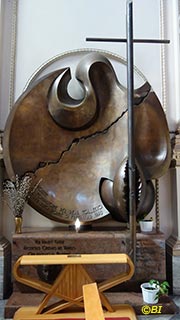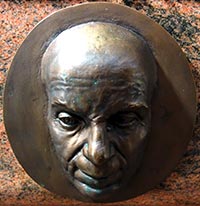The first two canvases of the altars of Santa Caritosa and Sant'Antonio da Padova were painted by Alessandro Abate from Catania (1867 - 1953); followed by photos of the painting of Maria Ausiliatrice (oil on canvas, 2.85 m by 1.70 m wide, by a painter from Turin) and of San Giuseppe e Gesù Bambino (oil on canvas, 2.85 m by 1.70 m wide, painted in 1915 by «A[ngelo] La Naia / Firenze 1915») and the two statues of San Rocco and Sant'Eligio.
Placed in the two niches of the side walls of the apse are the statues of San Rocco in his typical iconography (on the left) and, on the right, of Sant'Eligio bishop of Noyon (France), patron saint of goldsmiths, blacksmiths and veterinarians. Although well made and pleasant, they have nothing ancient; are from the time of construction of the church (1904 - 1914) by the Rosa Zanazio Company of Rome. It should be noted that while the presence of a Sant'Eligio in the traditional Bronte devotion seems strange, the one towards San Rocco, instead, has a historical explanation. The Church of the Sacred Heart was in fact erected largely on the area of an ancient Chapel dedicated to San Rocco, which since 1613 had also been the seat of the Confraternity of Maria SS. della Misericordia. The small church stood in a side street flanked on the corner by the old part of the Capizzi College. It was demolished in 1907 to make room for the church of the Sacred Heart under construction.
The Venerable's Funeral Monument  In the left part of the nave of the church, the remains of the founder of the College, Ven. Ignazio Capizzi, are preserved, transferred from Palermo to Bronte in April 1994. In the left part of the nave of the church, the remains of the founder of the College, Ven. Ignazio Capizzi, are preserved, transferred from Palermo to Bronte in April 1994.
The Venerable, upon his death (September 27, 1783) was buried in the Olivella convent in Palermo; subsequently, on July 29, 1949, considering the pitiful conditions to which the convent was reduced due to the air raids of 1943, his body was buried, again in Palermo, in the church of Sapienza, annexed to the college founded by the Venerable himself. On May 27, 1858, Ignazio Capizzi, for his theological virtues and the fruitful apostolate carried out in Sicily, was declared Venerable by Pius IX, who defined him as the Saint Philip Neri of Sicily.  The funeral monument, donated by Fininvest on the initiative of a former collegian, the Hon. Marcello Dell'Utri (then part of the Fininvest Group), is the work of the architect and sculptor from Catania Ivo Celeschi (1993). The funeral monument, donated by Fininvest on the initiative of a former collegian, the Hon. Marcello Dell'Utri (then part of the Fininvest Group), is the work of the architect and sculptor from Catania Ivo Celeschi (1993).
It represents the world, torn and upset by marginalization, injustice, violence, on which, from an open seed, a high cross sprouts and rises, a sign of hope and justice. It bears the inscription "Bronte - to the founder of the Real Collegio that boasts his name - A.D. 1993". Another inscription engraved almost hidden at the base of the monument, in recent decades a harbinger of violent controversy, reads "Gift of the Fininvest Group through the former student M. Dell'Utri".
|